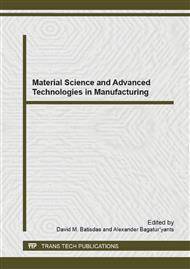[1]
J. E Shelby. Introduction to Glass Science and Technology. Published by The Royal Society of Chemistry, New York State College of Ceramics at Alfred University School of Engineering, Alfred, NY, USA. (2005).
Google Scholar
[2]
TIAN YingLing, LIANG XinHui, ZHANG Lei, et al. Exploration of ultrathin high-alkali alumino-silicate glass by float process technology (in Chinese) [J]. Journal of Wuhan University of Technology, 2010, 32(22): 102-106.
Google Scholar
[3]
M. Solvang, Y.Z. Yue, S.L. Jensen et al. Rheological and thermodynamic behaviors of different calcium aluminosilicate melts with the same non-bridging oxygen content. Journal of Non-Crystalline Solids. 336, (2004): 179-188.
DOI: 10.1016/j.jnoncrysol.2004.02.009
Google Scholar
[4]
Adam James Ellison, Sinue Gomez. Down-Drawable, chemically strengthened glass for glass cover plate: US 2008/0286548 A1[P]. 2007: 7-31.
Google Scholar
[5]
James.E. Shelby. Introduction to Glass Science and Technology (Second Edition) [M]. Published by the Royal Society of Chemistry, 2005: 26-161.
Google Scholar
[6]
Northwest Institute of Light Industry. Glass technology (in Chinese) [M]. Beijing: China Light Industry Press, 2007: 216-235.
Google Scholar
[7]
MA XiaoE. Materials Experimentation and Testing Technology (in Chinese) [M]. Beijing: China Electric Power Press, 2008: 130-133.
Google Scholar
[8]
Taner Yilmaz. Influence of annealing duration on the erosive wear behavior of polyphony lenesulphide composites[J]. Journal of Materials Science, 2010, 9: 2381-2389.
DOI: 10.1007/s10853-009-4204-2
Google Scholar
[9]
SU LiuMei, FAN Xing, YOU HongMei, et at. Thermal behavior and microstructure of ceramifiable polymer composites (in Chinese) [J]. Materials Science and Engineering of Powder Metallurgy, 2011, 16(6): 856-863.
Google Scholar
[10]
FAN Ying. To measure specific heat of high performance material by use of heat differential scanning (in Chinese) [J]. Shanghai Textile Science & Technology, 2005, 33(10): 26-28.
Google Scholar
[11]
YIN HaiRong, ZHANG ChunXiang, LIU LiYingt. Applications of Differential Thermal Analysis in Glass(in Chinese) [J]. Ceramics, 2008, 6: 14-18.
Google Scholar
[12]
TIAN YingLing. Study on Melting Reaction & Fining Mechanism of High Alkali Aluminosilicate Glass(in Chinese) [D]. Hubei Wuhan: Wuhan University of Technology, (2012).
Google Scholar
[13]
G. Brey. CO2 solubility and solubility mechanisms in silicate melts at high pressures[J]. Springer-Verlag, 1976, 2: 215-221.
DOI: 10.1007/bf00405226
Google Scholar
[14]
M. Fabian, F. Ito, K.M.T. Yamada. N2, O2, and Air Broadening of NH3 in ν2 Band Measured by FTIR Spectroscopy[J]. Journal of Molecular Spectroscopy, 1995, 173: 591-602.
DOI: 10.1006/jmsp.1995.1260
Google Scholar
[15]
MENG Zheng. The Investigation of Viscosity and Crystallization of Glass Frit in Different Temperature(in Chinese) [D]. Shandong Jinan: Shandong Institute of Light Industry. (2010).
Google Scholar
[16]
DENG Wei, CHENG JinShu, DENG ZhenLu, et al. Research on Sintering Reactions Process and Heat Calculation in Glass Batch(in Chinese) [J]. Journal of Wuhan University of Technology, 2010, 22(32): 111-113.
Google Scholar
[17]
М.А. Matveyev, Г.М. Matveyev, Б.Н. Eph positions Kyle. Glass chemical and industrial calculation (in Chinese) [M]. LI XiuZhong, ZHANG HouChen. China Building Industry Press, 1978: 228-272.
Google Scholar
[18]
J.M. Hutchinson. Studying the glass transition by DSC and TM DSC[J]. Journal of Thermal Analysis and Calorimetry. 2003, 72: 619-629.
Google Scholar


